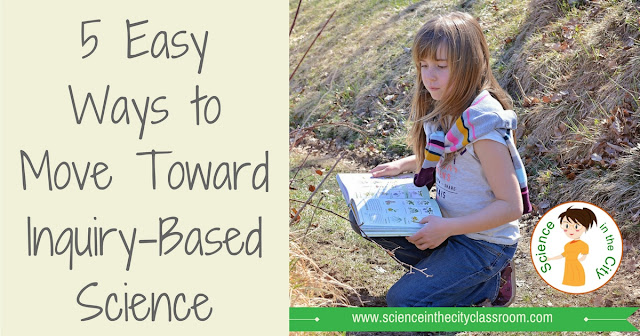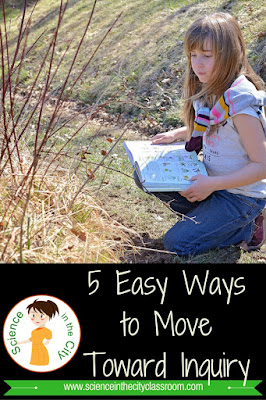5 Easy Steps to Add Inquiry into your Science Labs
We all know that there is a big push to increase inquiry in our science labs, but this is not always as easy as it seems. Often students are not ready for full-blown inquiry, and we as teachers do not have the time, materials, or resources to allow students to investigate their own questions within a classroom setting.
However, inquiry is based on student interest and relevancy, and on developing process skills so that students are acting as scientists, rather than just students. This can (and probably should) be done in small steps. Here are 5 easy ways to introduce more inquiry into your classroom.
 |
1) Start with a problem or a discrepant event BEFORE the activity
Inquiry is based on student driven questions. Part of that is students understanding the need to answer the question, or the relevancy of their topic. Before starting to the lab, show students why this topic is important. This could be through a short news story, a video clip, or even a made up story/scenario. It does, however, build in student engagement.
2) Student created hypothesis or question (with guidance)
Students often don't know how to create testable questions. This is a lesson by itself (or several lessons). Entire lessons can be taught on testable questions, but again, learning in context is preferable. One scaffolding step is to give students choices for a question or a hypothesis.
For example, students could be asked to choose a hypothesis, and complete the 'because'
A) If more fertilizer is applied, seedlings will grow taller because.....
B) If more fertilizer is applied, seedlings will grow less because....
C) If more fertilizer is applied, no change in seedling growth will happen because....
This allows students to test their own hypothesis, but it is fairly constrained.
Similarly, students can be given a topic, and write a question. For example, "We will be studying fertilizer and seedlings" These are the materials that we will be using (be sure to constrain the materials). What questions could we ask?
This will allow for a conversation about testable questions, but again, it is fairly constrained.
3) Student created data table
Students often have a difficult time organzing their data. This process can be scaffolded in many ways. A few ideas are:
- Give students a data table where they need to complete the labels before collecting data.
- Allow students to collect data and then have a class conversation on the board about how to organize the data.
- Have students create a data table and get it approved before collecting data.
4) Student created procedures
Students struggle with creating procedures in a clear, specific manner. The most simple method is to give students procedure steps out of order. They must correctly sequence the steps before they conduct their lab.
As a next step, students can write their own procedures, but in a very constrained setting. For example, I have created a resource where students are testing factors that affect evaporation. In this activity I have included several different versions of the activity. In one version, for example, students are asked to determine how wind speed affects evaporation rate. Given materials: fan, sponge, water, cardboard, stopwatch. In reality, there are a limited number of ways to do this experiment. However, it is a great opportunity for students to practice writing procedures. They have an opportunity to determine small choices about how their experiment is conducted (how much water, how long to time, how to measure), and practice acting as a scientist.
5) Vocabulary and reinforcement AFTER
Traditional labs often start with vocabulary words at the top, to be defined before the lab is conducted. There are often pre-lab questions of the concepts. This is the inverse of inquiry. Students, ideally, should learn the concepts through doing the lab. There is little incentive to do the lab if they understand all the concepts before. Instead, let them experience and then practice the vocabulary words and reinforce concepts after so that they have something to tie those vocabulary words on to.
There are many ways to help your students act as scientists, and learn science skills. These are just a few. I would love to hear how you introduce inquiry in your classroom.
(Full disclosure this whole post was finished and didn't save, so I had to re-type it. If there are errors please let me know. That's not the way to get my best work!)









No comments :
Post a Comment